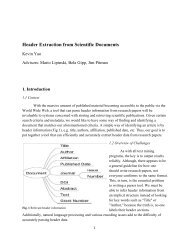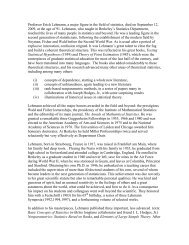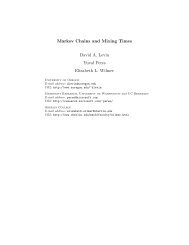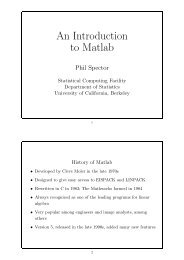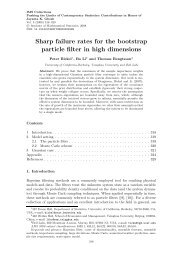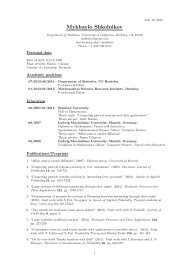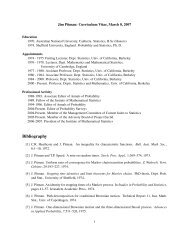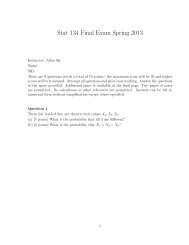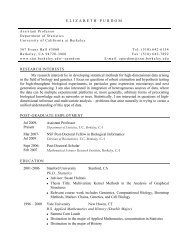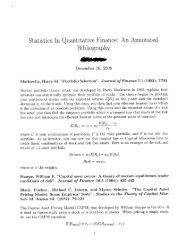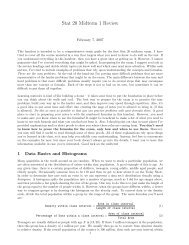Feller Processes and Semigroups
Feller Processes and Semigroups
Feller Processes and Semigroups
You also want an ePaper? Increase the reach of your titles
YUMPU automatically turns print PDFs into web optimized ePapers that Google loves.
2 <strong>Feller</strong> <strong>Processes</strong> <strong>and</strong> <strong>Semigroups</strong><br />
Lemma 27.1 (semigroup property). Probability kernels µ t , t ≥ 0 satisfy C-K relation iff the corresponding<br />
operators T t , t ≥ 0 have the semigroup property;<br />
T s+t = T s T t s, t ≥ 0<br />
Proof. Recall C-K equation: µ t µ s = µ s+t , i.e. for any bounded or nonnegative f, ∫ µ t (x, dy) ∫ µ s (y, dz)f(z) =<br />
∫<br />
µs+t (x, dz)f(z).<br />
For any B ∈ S,<br />
∫<br />
(T t T s )1 B (x) =<br />
µ s (x, dy)µ t (y, B)<br />
= µ s+t (x, B) C − K<br />
= T s+t 1 B (x)<br />
Now, Markov property can be equivalent with semigroup property. Naturally, we have two questions;<br />
• Add what kind of properties to the semigroup can we get Strong Markov property?<br />
• Add what kind of properties to the semigroup can we guarantee the cadlag modification?<br />
because without these two things, it’s hard to go further. There is an example which is a continuous Markov<br />
process but not a Strong Markov process:<br />
Example 27.2 (a continuous Markov process without Strong Markov property). (B t , t ≥ 0) is a<br />
Brownian motion not necessarily starting from 0. Let<br />
{<br />
Bt if B<br />
X t = B t 1 B0≠0 =<br />
0 ≠ 0<br />
0 if B 0 = 0<br />
whose transition kernels are<br />
µ t (x, dy) =<br />
{<br />
√1<br />
2πt<br />
e − (y−x)2<br />
2t dy if x ≠ 0<br />
δ 0 dy if x = 0<br />
It’s a Markov process because for any Borel set B,<br />
E[1 B (X t+s )|F s ] = E[1 B (X t+s ) · 1 B0≠0|F s ] + E[1 B (X t+s ) · 1 B0=0|F s ]<br />
∫<br />
1<br />
= 1 B0≠0 · √ e − (Xs−y)2<br />
2t dy + 1 B0=0 · 1 B (0)<br />
B 2πt<br />
∫<br />
∫<br />
1<br />
= 1 Xs≠0 · √ e − (Xs−y)2<br />
2t dy + 1 Xs=0 · 1 B (X s ) + 1 (B0≠0,X s=0) · (<br />
2πt<br />
= E1 B (X s )<br />
B<br />
B<br />
1<br />
√<br />
2πt<br />
e − (Xs−y)2<br />
2t dy − 1 B (0))<br />
where we use {B 0 ≠ 0} = {B 0 ≠ 0 X s ≠ 0} + {B 0 ≠ 0, X s = 0}, {X s = 0} = {B 0 ≠ 0 X s = 0} + {B 0 =<br />
0, X s = 0}, {B 0 = 0, X s = 0} = {B 0 = 0}, {B 0 ≠ 0, X s ≠ 0} = {X s ≠ 0} <strong>and</strong> 1 (B0≠0,X s=0) = 0 a.s.<br />
While it’s not a strong Markov process because if we look τ = inf t > 0, X t = 0, then ∀ x > 0,<br />
by P x (X 1 = 0) = 0.<br />
0 = P x (X 1 ≠ 0, τ ≤ 1) = P x (τ ≤ 1) > 0



